
2024 Fiat 500e Adaptive Cruise Control (ACC) User Guide
Learn how the 2024 Fiat 500e Adaptive Cruise Control (ACC) maintains a predetermined speed and adjusts to traffic circumstances, making driving smoother and safer with sophisticated automation.
2023 Fiat 500X Review, Price, Features And Mileage (Brochure)
ADAPTIVE CRUISE CONTROL (ACC)
Adaptive Cruise Control (ACC) increases the driving convenience provided by Cruise Control while traveling on highways and major roadways. However, it is not a safety system and not designed to prevent collisions. The Cruise Control function performs differently if your vehicle is not equipped with ACC.
ACC will allow you to keep Cruise Control engaged in light to moderate traffic conditions without the constant need to reset your speed. ACC utilizes a radar sensor and a forward facing camera designed to detect a vehicle directly ahead of you to maintain a set speed.
NOTE:
- If the ACC sensor detects a vehicle ahead, ACC will apply limited braking or accelerate (not to exceed the original set speed) automatically to maintain a preset following distance, while matching the speed of the vehicle ahead.
- Any chassis/suspension or tire size modifications to the vehicle will affect the performance of the Adaptive Cruise Control and Forward Collision Warning system.
- Fixed Speed Cruise Control (ACC not enabled) will not detect vehicles directly ahead of you. Always be aware of the feature selected.
WARNING!
- Adaptive Cruise Control (ACC) is a convenience system. It is not a substitute for active driver involvement. It is always the driver’s responsibility to be attentive of road, traffic, and weather conditions, vehicle speed, distance to the vehicle ahead and, most importantly, brake operation to ensure safe operation of the vehicle under all road conditions. Your complete attention is always required while driving to maintain safe control of your vehicle. Failure to follow these warnings can result in a collision and death or serious personal injury.
- The ACC system:
- Does not react to pedestrians, oncoming vehicles, and stationary objects (e.g., a stopped vehicle in a traffic jam or a disabled vehicle).
- Cannot take street, traffic, and weather conditions into account, and may be limited upon adverse sight distance conditions.
- Does not always fully recognize complex driving conditions, which can result in wrong or missing distance warnings.
You should turn the ACC system off:
WARNING!
- When driving in fog, heavy rain, heavy snow, sleet, heavy traffic, and complex driving situations (i.e., in highway construction zones).
- When entering a turn lane or highway off-ramp; when driving on roads that are winding, icy, snow-covered, slippery, or have steep uphill or downhill slopes.
- When towing a trailer up or down steep slopes.
- When circumstances do not allow safe driving at a constant speed.
Adaptive Cruise Control (ACC) Operation
The buttons on the right side of the steering wheel operate the ACC system.
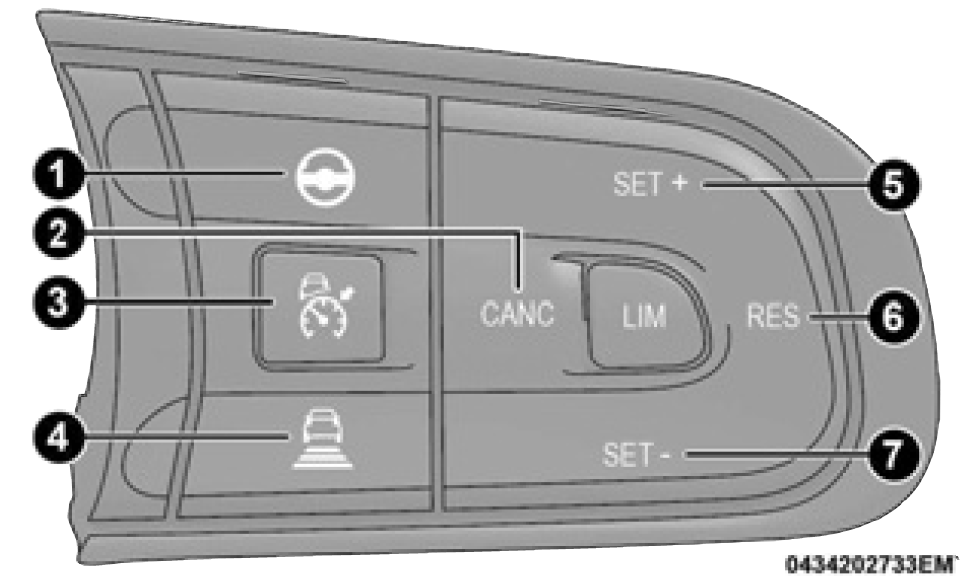
Adaptive Cruise Control Buttons
- Co-Driver On/Off Button
- CANC/Cancel
- Adaptive Cruise Control (ACC) On/Off
- Distance Increase/Decrease Button
- SET (+)/Accel
- RES/Resume
- SET (-)/Decel
Adaptive Cruise Control (ACC) Menu
The instrument cluster display shows the current ACC system settings. The information it displays depends on ACC system status.
Push the Adaptive Cruise Control (ACC) on/off button until one of the following shows in the instrument cluster display:
Adaptive Cruise Control Off
When ACC is deactivated, the display will read “Adaptive Cruise Control Off.”
Adaptive Cruise Control Ready
When ACC is activated but the vehicle speed setting has not been selected, the display will read “Adaptive Cruise Control Ready.”
Adaptive Cruise Control Set
When the SET (+) or the SET (-) button is pushed, the display will read “ACC SET.”
When ACC is set, the set speed will appear in the instrument cluster display.
The ACC screen may display once again if any of the following ACC activity occurs:
- System Cancel
- Driver Override
- System Off
- ACC Proximity Warning
- ACC Unavailable Warning
The instrument cluster display will return to the last display selected after five seconds of no ACC display activity.
Activating Adaptive Cruise Control (ACC)
The minimum set speed for the ACC system is 3 mph (5 km/h).
The maximum set speed is 90 mph (150 km/h).
When the system is turned on and in the ready state, the instrument cluster display will read “ACC Ready.”
When the system is off, the instrument cluster display will read “Adaptive Cruise Control (ACC) Off.”
NOTE:
You cannot engage ACC under the following conditions:
- When in 4WD Low
- When the brakes are applied
- When the parking brake is applied
- When the transmission is in PARK, REVERSE or NEUTRAL
- When the vehicle speed is below the minimum speed range
- When the brakes are overheated
- When the Electronic Stability Control (ESC), Anti-Lock Brake System (ABS), or other stability control systems are operating or have just operated
- During automatic braking by the Full Brake Control system (if equipped)
- When Cruise Control is activated
To Activate/Deactivate
Push and release the Adaptive Cruise Control (ACC) on/off button. The ACC menu in the instrument cluster display will read “ACC Ready.”
To turn the system off, push and release the Adaptive Cruise Control (ACC) on/off button again. At this time, the system will turn off and the instrument cluster display will read “Adaptive Cruise Control (ACC) Off.”
WARNING!
Leaving the Adaptive Cruise Control (ACC) system on when not in use is dangerous. You could accidentally set the system or cause it to go faster than you want. You could lose control and have a collision. Always ensure the system is off when you are not using it.
To Set A Desired Speed
When the vehicle reaches the speed desired, push the SET (+) button or the SET (-) button and release. The instrument cluster display will show the set speed.
While the accelerator pedal is pressed: a dedicated graphic with the symbol flashing will appear on the display for a few seconds; the system will not be able to control the distance between the car and the vehicle ahead. In this case the speed will be determined only by the position of the accelerator pedal.
To Cancel
The following conditions cancel the system:
- The brake pedal is applied.
- The CANC button is pushed.
- An Anti-Lock Brake System (ABS) event occurs.
- The gear selector is removed from the DRIVE position.
- The braking temperature exceeds normal range (overheated).
- The Electronic Stability Control, ABS, or other stability control system are in progress.
- The vehicle parking brake is applied.
- The driver switches ESC to Full Off mode.
- When the car speed is not within the settable speed range.
- When the Speed Limiter is active.
- An obstruction blocks the camera.
To Turn Off
To turn off and erase the set speed memory by pressing the Adaptive Cruise Control (ACC) on/off button or by placing the vehicle in the OFF position.
To Resume
If there is a set speed in memory, push the RES (resume) button and remove your foot from the accelerator pedal. The instrument cluster display will show the last set speed.
Resume can be used at any speed above 0 mph (0 km/h) when ACC is active.
WARNING!
The Resume function should only be used if traffic and road conditions permit. Resuming a set speed that is too high or too low for prevailing traffic and road conditions could cause the vehicle to accelerate or decelerate too sharply for safe operation. Failure to follow these warnings can result in a collision and death or serious personal injury.
To Vary The Speed Setting
To Increase Or Decrease The Set Speed
After setting a speed, you can increase the set speed by pushing the SET (+) button, or decrease speed by pushing the SET (-) button.
U.S. Speed (mph)
- Pushing the SET (+), or SET (-) button once will result in a 1 mph speed adjustment. Each subsequent tap of the button results in an adjustment of 1 mph.
- If the button is continually pushed, the set speed will continue to adjust in 5 mph increments until the button is released. The new set speed is reflected in the instrument cluster display.
Metric Speed (km/h)
- Pushing the SET (+), or SET (-) button once will result in a 1 km/h speed adjustment. Each subsequent tap of the button results in an adjustment of 1 km/h.
- If the button is continually pushed, the set speed will continue to adjust in 10 km/h increments until the button is released. The new set speed is reflected in the instrument cluster display.
NOTE:
When you override and push the SET (+) button or SET (-) button, the new set speed will be the current speed of the vehicle.
When ACC Is Active
- When you use the SET (-) button to decelerate, if the engine’s braking power does not slow the vehicle sufficiently to reach the set speed, the brake system will automatically slow the vehicle.
- The ACC system decelerates the vehicle to a full stop when following the vehicle in front. If your vehicle follows the vehicle in front to a standstill, after two seconds the driver will either have to push the RES (resume) button, or apply the accelerator pedal to reengage the ACC to the existing set speed.
- The ACC system maintains set speed when driving uphill and downhill. However, a slight speed change on moderate hills is normal. In addition, downshifting may occur while climbing uphill or descending downhill. This is normal operation and necessary to maintain set speed. When driving uphill and downhill, the ACC system will cancel if the braking temperature exceeds normal range (overheated).
To Vary The Speed With Intelligent
Adaptive Cruise Control
The Intelligent Adaptive Cruise Control system allows you to set a speed limit that matches the road sign detected by the Traffic Sign Recognition system. When a new speed limit is recognized, the TSR system will propose the new limit, and it will be displayed as a message on the instrument panel.
To accept the new limit, the driver can press the RES button to adjust the Adaptive Cruise Control speed to the speed suggested by the road sign.
The activation of the Intelligent Adaptive Cruise Control is indicated by the indicator light on the display and a green circle around the speed limit sign.
Setting The Following Distance In ACC
The specified following distance for ACC can be set by varying the distance setting between four bars (longest), three bars (long), two bars (medium) and one bar (short). Using this distance setting and the vehicle speed, ACC calculates and sets the distance to the vehicle ahead. This distance setting will show in the instrument cluster display.
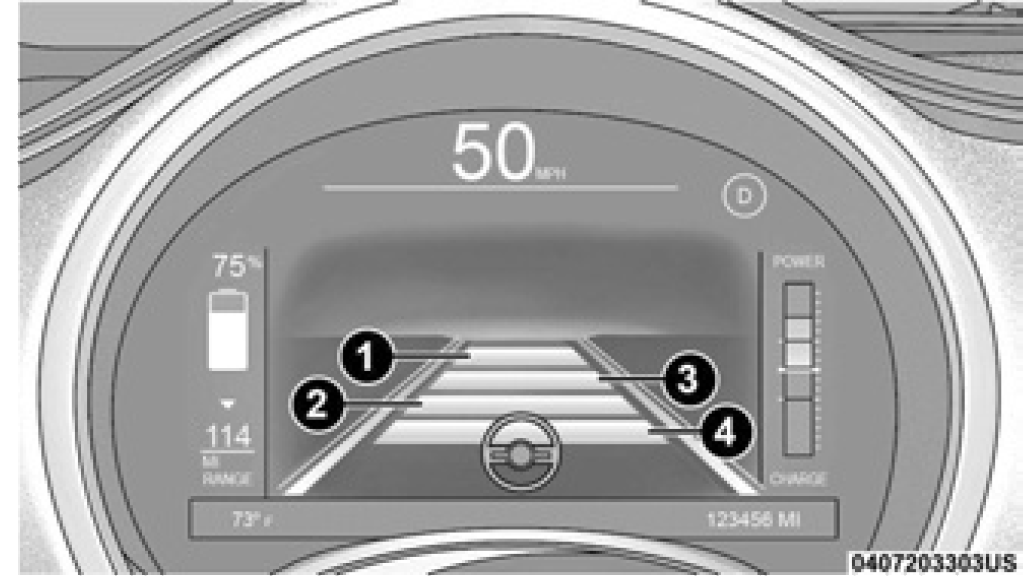
Distance Settings
- Longest Distance Setting (Four Bars)
- Medium Distance Setting (Two Bars)
- Long Distance Setting (Three Bars)
- Short Distance Setting (One Bar)
To decrease the distance setting, push the Distance button and release. Each time the button is pushed, the distance setting decreases by one bar (shorter). Once the shortest distance has been reached, one more press of the button will set the longest distance. The set speed is held if there are no cars ahead.
If a slower moving vehicle is detected in the same lane, the instrument cluster display will show the ACC Set With Target Detected Light . The system will then adjust vehicle speed automatically to maintain the distance setting, regardless of the set speed.
. The system will then adjust vehicle speed automatically to maintain the distance setting, regardless of the set speed.
The vehicle will then maintain the set distance until:
- The vehicle ahead accelerates to a speed above the set speed.
- The vehicle ahead moves out of your lane or view of the sensor.
- The distance setting is changed.
- The system disengages.
The maximum braking applied by ACC is limited; however, the driver can always apply the brakes manually, if necessary.
NOTE:
The brake lights will illuminate whenever the ACC system applies the brakes.
A Proximity Warning will alert the driver if ACC predicts that its maximum braking level is not sufficient to maintain the set distance. If this occurs, a visual alert “BRAKE!” will appear in the instrument cluster display and a chime will sound while ACC continues to apply its maximum braking capacity.
NOTE:
The “BRAKE!” screen in the instrument cluster display is a warning for the driver to take action and does not necessarily mean that the Full Brake Control system is applying the brakes autonomously.
Overtake Aid
The Adaptive Cruise Control system, when traffic conditions allow, offers an additional burst of speed to aid in passing other vehicles. To use, activate the turn signal to signal your intention to overtake. This extra acceleration is provided as long as there’s a safe distance between you and the vehicle you’re passing.
Once you feel the acceleration, it’s essential to ensure that it’s safe to change lanes, taking into account the traffic and vehicles approaching from behind. After making a clear path around other vehicles, the Adaptive Cruise Control will smoothly take over at your preset speed or reduce it to maintain your chosen following distance.
ACC Operation At Stop
If the ACC system brings your vehicle to a standstill while following a vehicle ahead, your vehicle will resume motion, without any driver interaction, if the vehicle ahead starts moving within two seconds of your vehicle coming to a standstill.
If the target vehicle does not start moving within two seconds of your vehicle coming to a standstill, the ACC with Stop system will cancel and the brakes will release. A cancel message will display on the instrument cluster display and produce a warning chime.
When traveling at speeds below 36 mph (60 km/h) and with good visibility, the system can identify stationary vehicles and reduce speed to maintain a safe following distance. Once the car comes to a complete stop, ACC will turn off. You can reactivate the system when your speed is above 5 km/h (3 mph) by pressing any of the SET+, SET-, or RES buttons.
If the system keeps the vehicle stationary for two minutes, the electric parking brake will engage, and the system will be deactivated.
WARNING!
When the ACC system is resumed, the driver must ensure that there are no pedestrians, vehicles or objects in the path of the vehicle. Failure to follow these warnings can result in a collision and death or serious personal injury.
Speed Reductions On Bends
The Adaptive Cruise Control system has the capability to make slight speed reductions during bends to enhance vehicle stability and passenger comfort. This feature can be especially helpful in roundabouts or on gently curved roads where the curvature gradually increases.
However, it cannot compensate for abrupt steering maneuvers or moderate-to-high lateral accelerations in general.
In scenarios where the traffic situation demands it, it is the drivers responsibility to apply the brakes, as needed, to further decrease the vehicle’s speed, ensuring stability on tight bends or steep descents.
Extension Of Adaptive Cruise Control: Co-Driver
The Adaptive Cruise Control system can operate in coordination with the Co-Driver system to provide “Autonomous Level 2 Assistance.” The Co-Driver is capable of maintaining a consistent speed and distance, adaptable to the vehicles ahead, and keeping the car centered within the lane.
NOTE:
This system is designed to assist the driver, who should always remain fully attentive while driving. The ultimate responsibility lies with the driver, who must consider the traffic conditions to ensure safe driving.
The driver should remain vigilant on the road and keep their hands on the steering wheel at all times.
Display Warnings And Maintenance
“FRONT RADAR SENSOR TEMPORARILY BLOCKED”
WARNING
The “ACC Front Radar Sensor Temporarily Blocked” warning will display and a chime will sound when conditions temporarily limit system performance.
This most often occurs at times of poor visibility, such as in snow or heavy rain. The ACC system may also become temporarily blinded due to obstructions, such as mud, dirt or ice. In these cases, the instrument cluster display will read “ACC/FCW Unavailable Wipe Front Radar Sensor” and the system will deactivate.
The “ACC Front Radar Sensor Temporarily Blocked” message can sometimes be displayed while driving in highly reflective areas (i.e. ice and snow, or tunnels with reflective tiles). The ACC system will recover after the vehicle has left these areas. Under rare conditions, when the radar is not tracking any vehicles or objects in its path this warning may temporarily occur.
NOTE:
If the “ACC Front Radar Sensor Temporarily Blocked” warning is active, Fixed Speed Cruise Control is still available.
If weather conditions are not a factor, the driver should examine the sensor. It may require cleaning or removal of an obstruction. The sensor is located in the center of the vehicle behind the lower grille.
To keep the ACC System operating properly, it is important to note the following maintenance items:
- Always keep the sensor clean. Carefully wipe the sensor lens with a soft cloth. Do not use solvents or abrasive substances.
- Do not remove any screws from the sensor. Doing so could cause an ACC system malfunction or failure and require a sensor realignment.
- If the sensor or front end of the vehicle is damaged due to a collision, see an authorized dealer for service.
- Do not attach or install any accessories nearthe sensor, including transparent material or aftermarket grilles. Doing so could cause an ACC system failure or malfunction.
When the condition that deactivated the system is no longer present, the system will return to the “Adaptive Cruise Control Off” state and will resume function by simply reactivating it.
NOTE:
- If the “ACC Front Radar Sensor Temporarily Blocked” message occurs frequently (e.g. more than once on every trip) without any snow, rain, mud, or other obstruction, have the radar sensor realigned at an authorized dealer.
- Installing a snow plow, front-end protector, an aftermarket grille or modifying the grille is not recommended. Doing so may block the sensor and inhibit ACC/Full Brake Control System operation.
“CLEAN FRONT WINDSHIELD” WARNING
The “ACC/FCW Limited Functionality Wipe Front Windshield” warning will display when conditions temporarily limit system performance. This most often occurs at times of poor visibility, such as in snow or heavy rain and fog. The ACC system may also become temporarily blinded due to obstructions, such as mud, dirt, or ice on windshield and fog on the inside of glass. In these cases, the instrument cluster display will read “ACC/FCW Limited Functionality Wipe Front Windshield” and the system will have degraded performance.
The “ACC/FCW Limited Functionality Wipe Front Windshield” message can sometimes be displayed while driving in adverse weather conditions. The ACC/Full Brake Control system will recover after the vehicle has left these areas. Under rare conditions, when the camera is not tracking any vehicles or objects in its path this warning may temporarily occur.
If weather conditions are not a factor, the driver should examine the windshield and the camera located on the back side of the inside rear view mirror. They may require cleaning or removal of an obstruction.
When the condition that created limited functionality is no longer present, the system will return to full functionality.
NOTE:
If the “ACC/FCW Limited Functionality Wipe Front Windshield” message occurs frequently (e.g. more than once on every trip) without any snow, rain, mud, or other obstruction, have the windshield and forward facing camera inspected at an authorized dealer.
SERVICE ACC/FCW WARNING
If the system turns off, and the instrument cluster display reads “ACC/FCW Limited Functionality Frontal Camera Service Required” or “Cruise Control Service Required”, there may be an internal system fault or a temporary malfunction that limits ACC functionality.
Although the vehicle is still drivable under normal conditions, ACC will be temporarily unavailable. If this occurs, try activating ACC again later, following an ignition cycle. If the problem persists, see an authorized dealer.
Precautions While Driving With ACC
In certain driving situations, ACC may have detection issues. In these cases, ACC may brake late or unexpectedly. The driver needs to stay alert and may need to intervene. The following are examples of these types of situations:
TOWING A TRAILER
Towing a trailer is not recommended when using ACC.
OFFSET DRIVING
ACC may not detect a vehicle in the same lane that
is offset from your direct line of travel, or a vehicle merging in from a side lane. There may not be sufficient distance to the vehicle ahead. The offset vehicle may move in and out of the line of travel, which can cause your vehicle to brake or accelerate unexpectedly.
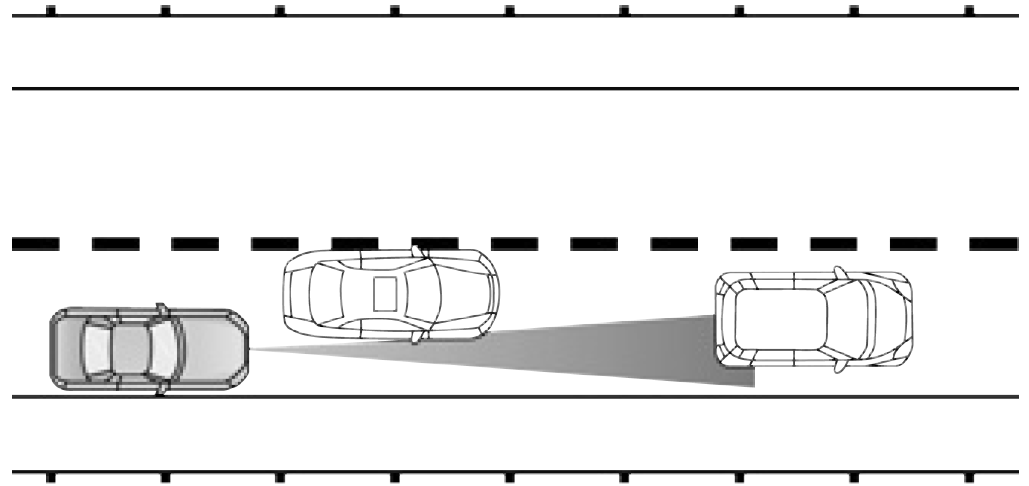
Offset Driving Condition Example
TURNS AND BENDS
When driving on a curve with ACC engaged, the system may increase or decrease the vehicle speed for stability, with no vehicle ahead detected. Once the vehicle is out of the curve, the system will resume your original set speed. This is a part of normal ACC system functionality.
NOTE:
On tight turns ACC performance may be limited.
USING ACC ON HILLS
ACC performance may be limited when driving on hills. ACC may not detect a vehicle in your lane depending on the speed, vehicle load, traffic conditions, and the steepness of the hill.

ACC Hill Example
LANE CHANGING
ACC may not detect a vehicle until it is completely in the lane in which you are traveling. In the following lane changing example, ACC has not yet detected the vehicle changing lanes and it may not detect the vehicle until it’s too late for the ACC system to take action. ACC may not detect a vehicle until it is completely in the lane. There may not be sufficient distance to the lane-changing vehicle. Always be attentive and ready to apply the brakes if necessary.
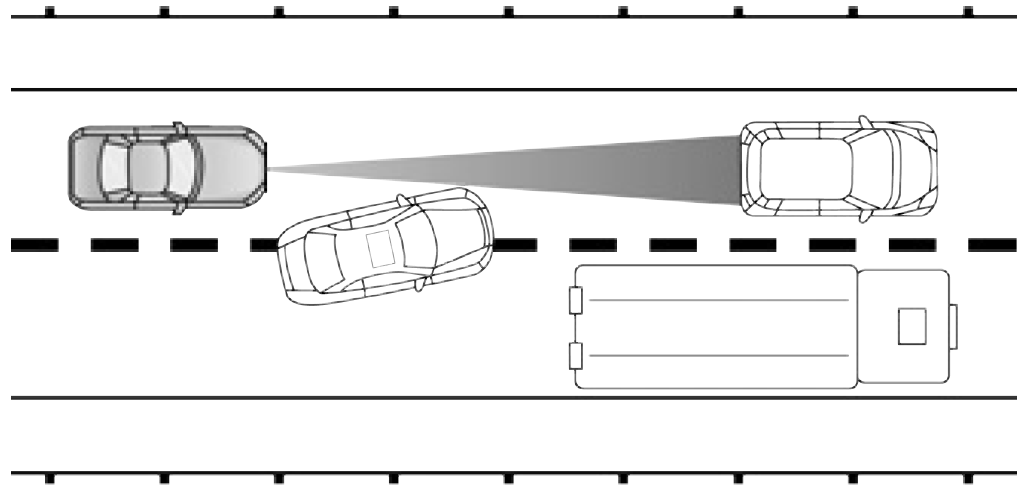
Lane Changing Example
NARROW VEHICLES
Some narrow vehicles traveling near the outer edges of the lane or edging into the lane are not detected until they have moved fully into the lane. There may not be sufficient distance to the vehicle ahead.
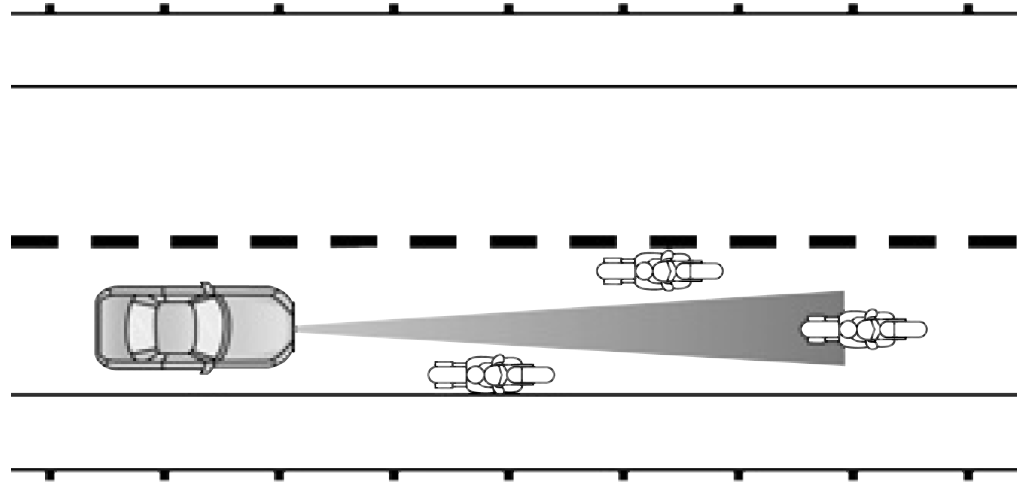
Narrow Vehicle Example
STATIONARY OBJECTS AND VEHICLES
ACC does not react to stationary objects or vehicles. For example, ACC will not react in situations where the vehicle you are following exits your lane and the vehicle ahead is stopped in your lane. It will consider this stopped vehicle a stationary object as it did not previously detect movement from it. Always be attentive and ready to apply the brakes if necessary.

Stationary Object And Stationary Vehicle Example
OBJECTS AND VEHICLES MOVING IN OPPOSITE OR PERPENDICULAR DIRECTION
The system cannot detect objects or vehicles traveling in the opposite or perpendicular direction, and therefore will not activate.
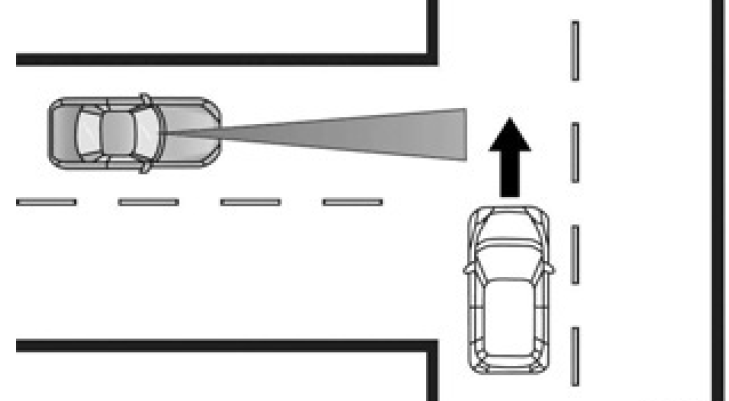
Objects Moving in Perpendicular Direction Example
Useful Links:
2023 Fiat 500X Review, Price, Features And Mileage (Brochure)

